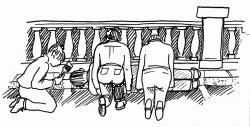Man's measure: Why Harvard Bridge is 364 Smoots long
Q. How did the Harvard Bridge, connecting the Massachusetts Institute of Technology with its fraternities across the Charles River, come to be 364.4 "Smoots" long? (The local police didn't exactly like it.) –D. Aller
A. Make that 364.4 Smoots plus one ear, to be precise, says David Halliday in Fundamentals of Physics. The unit of one Smoot is based on the 5'7" height of Oliver Reed Smoot Jr., class of 1962, who was carried or dragged length by length across the bridge as other pledges of the Lambda Chi Alpha fraternity marked off each Smoot length with paint.
The marks have been repainted biannually, usually during times of heavy traffic congestion so the police cannot easily interfere. Presumably, the police were originally upset because the Smoot is not an SI base unit (International System of Units), but nowadays they seem to have accepted the tradition.
Ironically, Smoot went on to become president of the International Organization for Standardization and served as chair of the American National Standards Institute.
Q. Daydreams can give us all sorts of pleasure, and why shouldn't they? We produce these private movies in our heads where we're the stars, with limitless budgets, a free hand in casting, great special effects, and no censors. So why are our night dreams so much more fun? –C. Nolan
A. Daydreams suffer from a "shortage of scarcity," says Paul Bloom in How Pleasure Works: The New Science of Why We Like What We Like, quoting psychiatrist George Ainslie. Daydreams can go on and on, but they never surprise us. We are too much in control, whereas many real-world pleasures involve some loss of control. There is nothing we can't do in a daydream, and so where's the value in success and triumph?
That point was made in a classic Twilight Zone episode where a violent thug dies and finds himself in a place where his every wish is satisfied. He is shocked to
be in paradise having a wonderful time. Soon, however, he finds himself getting bored and after a while tells his guide, "I don't belong in heaven, see? I want to go to the other place." The guide responds, "Whatever gave you the idea that you were in heaven? This is the other place!" Cue maniacal laughter.
Daydreams are the opposite of dreams because in dreams we typically have no control at all, meaning that, "A good dream can be more pleasurable than a good daydream, while a nightmare can be terrible indeed."
Q. What's one surprising way "The quick brown fox jumpS over the lazy dog" may become "The quick brown fox jumpED over the lazy dog"? –M. Beacon
A. When someone takes a "pangram" such as the first sentence (which contains all 26 letters of the alphabet) and makes it into a "lipogrammatic pangram" such as the second sentence (which omits a particular letter, in this case "s"). This actually happened inadvertently to the authors, who cited the above lipogrammatic pangram as a full pangram without noticing that the "s" had been switched to "ed" in
the sentence. Our astute column readers noticed the s-less- ness of our flawed pangram and let us know about it. Our thanks to you all, so much more awake than we proved to be.
We are now more on the alert for lipograms (from Greek "lipo-" for "lacking" and "gram" for "something written"), which have quite a history. Writing a lipogram isn't so difficult if an uncommon letter like "z", "j" or "x" is omitted, yet it's much rarer to write a free-flowing sentence or prose without an "e," "t" or "a." One remarkable early example is Ernest Vincent Wright's 1939 novel Gadsby, with over 50,000 words but not a single letter "e"– just another of those self-imposed challenges we humans love so much.
~
Send Strange questions to brothers Bill and Rich at [email protected].
